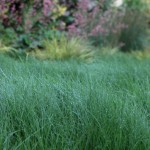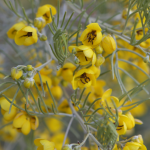The (False) Choice Between Water and Energy Savings
Our wet-to-dry exchanges normally provide an optimally sustainable alternative to a popular and aesthetically similar plant. As it is hotter than Hades this month, we thought we’d pause our talk of LA’s better angels to discuss the lesser of two evils. What causes greater harm – grass or gravel-as-lawn-scapes?

Grass
Area municipalities and water districts offered incentives for lawn removal for good reasons. Turf grasses – those that make up our traditional lawns – consume more water than pools! Yikes!
While we strongly advocate for authentic LA landscapes and IdealMow lawns, much of the harm caused by turf can be mitigated without re-landscaping. Turf can survive on much less water than it typically receives, and allowing it to go dormant will save even more.
While letting a lawn go brown isn’t the worst thing, it may mean walking away from more than one kind of green. Swapping turf and sprinklers for an IdealMow lawn with smart irrigation can save families more than save $30,000– more than $3,000/year per 1000 square feet – in water and lawn maintenance costs alone. Beyond lawn care savings, a landscape designed to optimize energy efficiency can pay for itself in just 8 years.
That said, there are materials, like gravel, that cost the city and homeowners more.
Gravel
As Angelenos sought to address the drought, many replaced thirsty traditional lawns with gravel or crushed stone and cacti. In some communities, gravel gardens became the look of doing one’s part. People were sold a no-brainer: replace a lawn with gravel free-to-you, then cash in on water savings. Ironically those “free” gravelscapes now come with a heavy cost to both homeowners and LA.
What gravelscape owners save on water bills, they more than pay out in power bills increases. According to the Department of Energy, during the day, gravelscapes can increase outdoor temperatures by more than 5.4°F. In the evening, they hold heat keeping temperatures more than 22°F higher. Increases in outdoor heat of this magnitude can increase air conditioning costs by as much as 50 percent when compared to an energy efficient landscape.
The cost of gravel isn’t born by just one homeowner. A gravelscape can heat neighbors’ homes. As more neighbors also plant gravel, it amplifies temperatures of full neighborhoods and hardens the land. Temperatures continue to grow as gravelscapes kill trees, reducing shade.

Gravel, Grass and Green
Clearly, grass is a better way to stay in the green when we take a long term view. Grass also makes sense when considering initial costs and how quickly they can be recouped.
Now that turf removal grants are not there to tip the balance, the initial costs of replacing turf with gravelscape and with IdealMow lawn alternatives is remarkably similar. Installing gravelscape costs $7-8 per square foot, while replacing a lawn with an IdealMow lawn alternative will cost $6-12 per square foot, depending on the specific grass of interest.
Whether we prioritize the green in our wallets or the greenery and overall resilience of our city, our own native grasses are the no brainer.
More Information
- Heat Island Effect, Environmental Protection Agency
- Don’t Gravelscape Los Angeles, Los Angeles Times
- Landscaping for Shade, U.S. Department of Energy
- Energy Saver 101 Infographic, U.S. Department of Energy
- Landscaping for Shade, Environmental Protection Agency
- Low-Hanging Fruit in Green Building, USGBC Green Home Guide
- Two Degrees: The Built Environment and Our Climate Change




